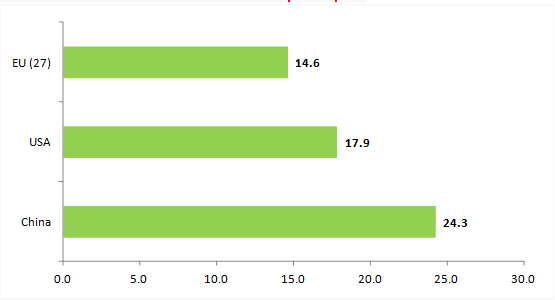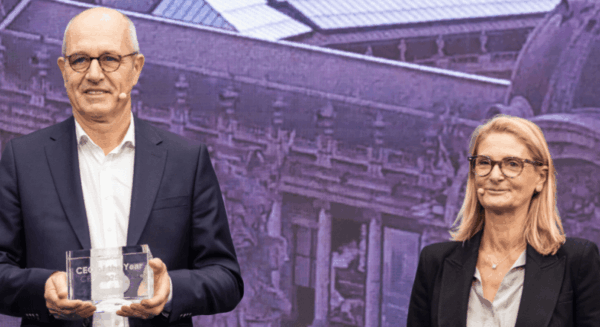Valeo Group | Nov 25, 2025 | 2 min
- #FutureMobility
Urban Mobility in China
A vehicle ownership boom over the last 20 years has turned China into the world’s largest passenger car market. Alongside this boom, Chinese cities have taken on an overwhelming concentration of cars, throwing the challenges of modern urban mobility into stark relief. Limiting the economic and environmental costs of this urban transformation will require not only technological innovation, but also the encouraging of new practices.
Massively urbanized, massively motorized
As late as 1990, there were only 800,000 privately owned vehicles in the entire Chinese nation. In 2015, that number reached a staggering 279 million. In urban areas, vehicle use compounds pre-existing air pollution issues, and new problems have cropped up: increased fuel consumption, lost productivity due to traffic congestion, and other quality of life issues such as noise pollution. Faced with a billion-strong urban population by 2030, the Chinese market will be defined by dynamic growth and stringent environmental concerns for years to come.
World’s n°1 passenger car market (2015 figures)
China’s urban driving population (April 2016)
Doing more with less
Fuel efficiency will be among the main concerns associated with China’s increasingly motorized population. If and when the country reaches vehicle ownership rates comparable to those of the European Union—not to mention the USA—the impact on the world’s energy resources and the environment would be dramatic.
Technologies such as Valeo Stop-Start solutions address the specific overconsumption incurred by traffic congestion. In Beijing, for instance, the 2016 average work commute was 50 minutes long, but only involved an average speed of 23,6 km/h: cutting engines’ idling time would lessen this trend’s impact on both fronts. Hybrid systems could have a similar effect if made more widely accessible—a challenge the Valeo Hybrid4All system was designed to meet with its combined combustion and low-power electric engines.
Electrifying the future
The Chinese government shows decisive support for New Energy Vehicles (NEVs), notably through significant subsidies. As such, while NEVs only accounted for 2% of the country’s total market in 2016, this represented a 53% year-on-year growth. Valeo is at the forefront of the electrification of car engines, as seen with its electric supercharger, and has recently entered a joint-venture with Siemens dedicated to high voltage powertrains.
Helping drivers breathe more easily
China’s motorization boom has contributed to the country’s very high levels of air pollution, which are a national health concern. In an already hazardous environment, limiting drivers’ and passengers’ exposure to particulates and gases is doubly important. Indeed, studies show that the air inside the vehicle cabin can be two to five times more polluted than the outside environment. Leading-edge cabin filters can protect people’s health and comfort inside the car by trapping allergens, dust and particles. Valeo’s very high efficiency PM2.5 filter, notably, can reduce particle concentration inside a vehicle to levels meeting the WHO Air Quality Guidelines of 25 µg/m3 per day—to be contrasted with the average of 73 µg/m3 in Beijing in 2016.
Demand for connectivity
In a market where the automotive boom is associated with such significant costs, it stands to reason that there will be a high demand for technologies that make driving more intuitive and comfortable. As such, it should come as no surprise that Chinese customers are especially enthusiastic about connected vehicles. McKinsey has found that 60% of customers surveyed would be ready to switch car brands for increased connectivity. The Chinese market offers a direct example of the ways increasingly connected vehicles are not merely more convenient, but can also make urban driving more efficient and safer. This is true of parking, with technologies like the 360Vue Surround view system and Park4U. In a country wherein two-wheel vehicles currently remain the most popular, technologies such as Sightstream also make it safer to share the road.
While Chinese urban areas shine a light on the key challenges for urban mobility in the 21st century, the market dynamics at work are already showing the way forward. Stringent environmental requirements will certainly help mitigate the impact of this massive motorization, but a new approach that emphasizes connectivity and efficiency will be key—as will emerging mobility practices such as car sharing.
Other sources:
http://www.chinadaily.com.cn/business/motoring/2016-01/18/content_23132935.htm
http://www.pewresearch.org/fact-tank/2015/04/16/car-bike-or-motorcycle-depends-on-where-you-live/





